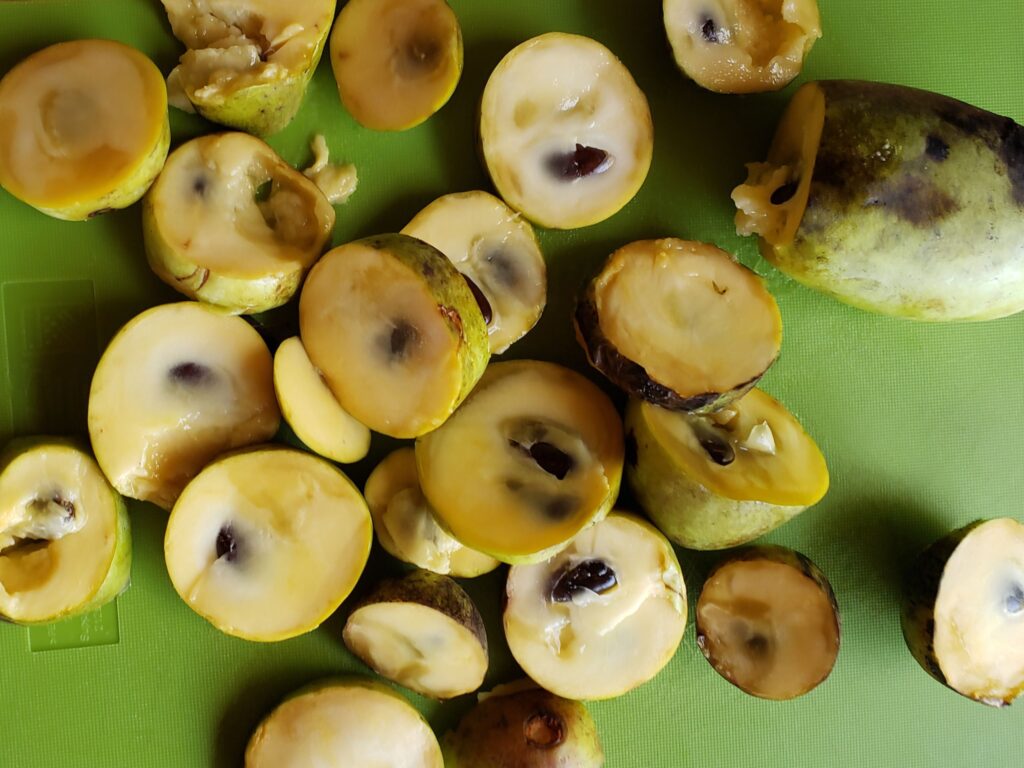A Guide to Safely Preparing and Storing Your Fruit Harvest
This post contains affiliate links. As a member of Amazon Associates, I may earn a commission on qualifying purchases at no cost to you.
You’ve struck pawpaw gold at the farmers market or a secret foraging spot. Now what?
This post offers information on careful handling, processing, and storage of fruit – depending on the volume collected during peak season.
Ripe for the Taking
Successful pulp processing starts with identifying ripe fruit. Use the Goldilocks principle to find pawpaws that are “just right” with the following tips:
- A peduncle is the stalk attaching the pawpaw to the tree. If the “shoulder” of the fruit yields to gentle pressure, it is ready to harvest with a delicate twist.
- With a soft squeeze, pawpaws have the same “give” as a ripe avocado or peach.
- The nose knows: ripe pawpaws release an unmistakable fruity aroma that can fill a room. Although certain folks have described this scent as “cloying” there is no better signal that the season is in full swing.
- Depending on the cultivar, the skin may slightly fade to light green or yellow. Undamaged fruit with brown or black skin can be edible, and some people enjoy the butterscotch-like flavor of overripe pawpaws.
- “Thump!” Ideally, you’re picking pawpaws directly from trees but any fruit that has dropped to the ground can go into your pocket. Please be kind and avoid shaking trees.
- Cultivars have a wide range of pulp colors and flavors. However, move on if the inside of the fruit is white and hard like a green tomato.
Read more about food safety, storage, and purchasing fruit in the sections below.
Scoop, Peel, or Squeeze?
A consensus has not been reached on the most efficient way to separate pawpaw pulp from the skin. For now, it comes down to personal preference.
All approaches are manual and may require an extra set of hands to speed up the process.
Scooping (Fresh Fruit Cut in Half)
- What You’ll need: Spoon or Cookie Scoop
- Advantages: Can be quickly executed while discarding bruised areas
- Disadvantages: Potential bitterness if skin is spooned into the pulp mixture
Peeling (Whole Fresh Fruit)
- What You’ll Need: Paring Knife
- Advantages: Minimal waste of pulp
- Disadvantages: Fruit handling will be very challenging if overripe; potential bitterness if skin is shaved into the pulp mixture
Peeling (Frozen Whole Fruit)
- What You’ll Need: Food Peeler
- Advantages: Minimal waste of pulp; easy post-harvest storage for “as needed” processing
- Disadvantages: Seeds will not be viable for planting; expect fingers to go numb after handling frozen fruit for extended periods of time
Squeezing (Fresh Fruit Cut in Half)
- What You’ll Need: Plastic Gloves
- Advantages: Can be quickly executed, especially if fruit is soft and ripe
- Disadvantages: Potential lost pulp not scraped from the skin
Next, the tricky part: what to do about seeds in the pulp mixture? This depends on the size of the batch (i.e., small, medium, or large).
Pawpaw seeds are dark brown, roughly the size of a lima bean, and covered in edible flesh. Most importantly, the seed material cannot be consumed and needs to be removed.
Small Batch Processing
For small harvests, here is a sampling of tried-and-true techniques:
- Separating seeds by hand and running the pulp through a food mill
- Squeezing the pulp through a food-safe mesh bag into a bowl
- Pressing the pulp through a colander or wire basket
- Agitating the pulp with a kitchen mixer, using a beater paddle or standard wire whip for at least 5-10 minutes
Pro Tip: Run the prepared pulp through a blender or food processor to create a smooth puree that will work better for most recipes, especially desserts.
Medium to Large Batch Processing
Kentucky State University suggests a sauce maker with a modified grape spiral and pumpkin screen. The strainer can be operated with a manual hand crank or become semi-automated with a motor attachment.
Storage
Pawpaws have a notoriously short shelf life. At room temperature, they can last approximately two to three days before breaking down into mush. You can extend longevity to two or three weeks by storing clean fruit in the refrigerator.
When processing any size batch, work fast since air exposure will result in browning. This will also occur when frozen pawpaw pulp is defrosting. Adding a splash of lemon juice or Ball Fruit Fresh according to directions can help but may marginally affect the flavor.
Pro Tip: Spoon processed pulp into Souper Cubes Silicon Trays and freeze. When ready, vacuum seal or transfer to storage bags for easy stacking. Stick with Ziploc Freezer Bags for the quality even though private-label options at the grocery store could save a few pennies.
Pawpaw pulp will keep in the freezer for up to 18 months without any noticeable change in taste (e.g., bitterness). After thawing, use the pulp within one to two days due to natural bacterial growth and do not refreeze leftovers.
Commercial Processing
Commercial kitchens require significant investments along with state licenses, permits, and inspections. There are a limited number of private facilities for pawpaws in Ohio and Indiana, and the operators have aligned on the Robot Coupe as the go-to machine to manage high-volume pulp processing.
Robot Coupe C 80 Automatic Sieve
Parts include hopper, perforated basket, paddles, finished product ejection chute, and waste ejection chute. Request an in-person product demonstration with one of the company’s chefs via the website.
In 2015, Kentucky State University launched the country’s first Fruit and Vegetable Mobile Processing Unit thanks to funding support from the U.S. Department of Agriculture and the Kentucky Agricultural Development Fund.

Kentucky State University
“Enhancing services to under-served limited-resource farmers, who are often not reached by traditional cooperative extension approaches, in the safe commercial processing of fruits and vegetables will significantly increase economic opportunities for these individuals.” – Excerpt from press release on May 21, 2015
For aspiring entrepreneurs, Appalachian Center for Economic Networks (ACEnet) in Athens, Ohio offers economic development opportunities, networking support, and rental spaces.
“ACEnet began developing the Food Ventures Center, a sector-specific incubator focused on the needs of companies producing specialty food products…The Food Ventures Center provide[s] licensed commercial kitchen space for entrepreneurs to develop and produce their product lines without the financial burden of paying individually for licensing.” – Excerpt from ACEnet History
Food Safety and Cottage Food Laws
Fake news about food safety hurts the pawpaw industry; however, there are important considerations to prevent bad experiences – or worse, serious illness caused by needless mistakes.
Every year, there are stories about pawpaw sickness ranging from mild discomfort to symptoms like serious food poisoning. Potential fruit allergies should be monitored and assessed through mini taste samplings. Some of the most well-documented reactions are around apples, peaches, and mangoes.
Here are important pointers to keep your family and friends safe:
- Follow basic safe food guidelines for all fresh produce
- Do not eat the skin. Although not harmful, the skin is bitter and negatively impacts the flavor of the pulp.
- Do not consume leaves, bark, or twigs. This is a key distinction between papayas (Carica papaya) and pawpaws (Asimina triloba). American pawpaw trees contain acetogenins, a toxin that works as a natural insecticide in the plants. For this reason, do not prepare homemade teas, tinctures, or other extracts.
- Do not eat unripe fruit. See “Ripe for the Taking” (above) to select the best fruit.
- Do not eat any seed materials. Toxic substances in the seeds (along similar lines as apple seeds and cherry pits) can cause illness. Be careful when processing pulp, especially in blenders and food processors.
- Do not dehydrate pulp. Native American methods of preserving the fruit have been lost to history. However, the effects of modern dehydration are quick and severe: vomiting, cramps, and diarrhea. In rare cases, some people require trips to the emergency room.
- Do not eat fruit punctured or damaged by critters. Although it may be tempting to salvage tampered fruit, we can guarantee that raccoons and opossums are not using hand sanitizer on their dirty little nails.
Cottage food laws vary by state but products that require refrigeration generally need to meet licensing and other legal conditions. If purchasing processed pulp, make sure you are sourcing from a trusted vendor with a commercial kitchen.
Tracking Down Fruit
Demand for pawpaws continues to exceed the supply. The good news is that there are some reliable options in the market that include shipping to customers.
Foraged Market has created a new “forest-to-table” community by providing access to wild and specialty foods.
Pawpaws from Earthy Delights have been featured on the Today Show. The Michigan-based company offers fresh fruit, frozen pulp, and a selection of other products.
Several of the licensed nurseries for Peterson Pawpaws and Kentucky State University (KSU) cultivars manage pawpaw orchards. Also, check with your local greenhouse, agricultural extension office, or farmers market for possible leads

